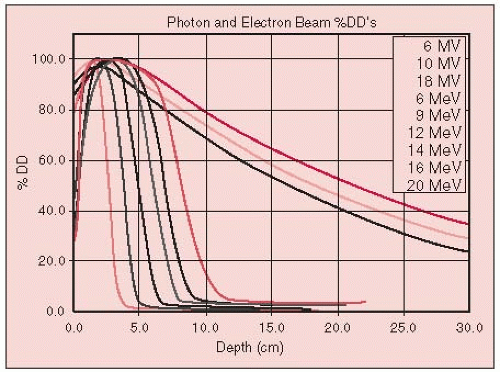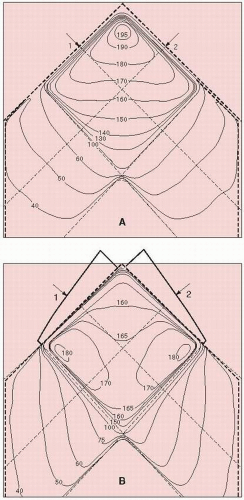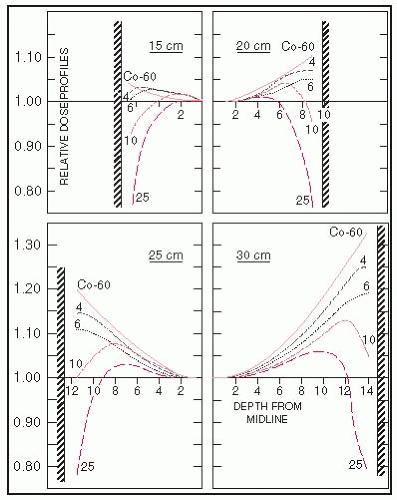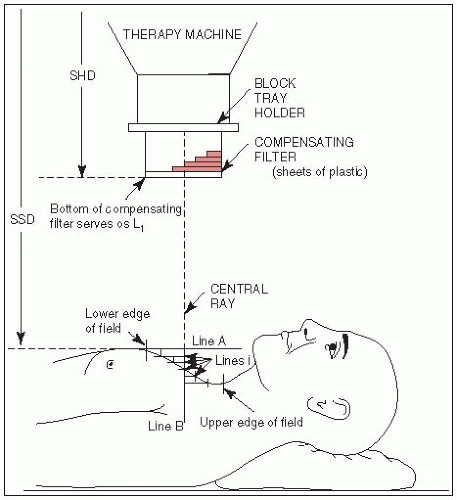The central axis percentage depth dose (PDD) expresses the penetrability of a radiation beam.
Beam characteristics for x-ray and gamma-ray beams typically used in radiation therapy, the depth at which the dose is maximum (100%), and the PDD value at 10-cm depth are summarized in Table 2-1 and Figure 2-1.
For a 10 × 10-cm field, 18- and 6-MV x-ray beams and cobalt-60 (60Co) beams (1.25 MV average x-ray energy) lose approximately 2.0%, 3.5%, and 4.5% per cm, respectively, beyond the depth of maximum dose (dmax).
Cobalt units exhibit a large penumbra, and their isodose distributions are rounded toward the source as a result of the relatively large source size (typically 1 to 2 cm in diameter). Linear accelerator (linac) isodose distributions have much smaller penumbras and relatively flat isod ose curves at depth.
The buildup region is very energy dependent (Fig. 2-1).
If the x-ray beam is incident normal (at 0 degrees) to the surface, maximum skin sparing is achieved.
Perturbation of photon transport is more noticeable for lower-energy beams.
For a modest lung thickness of 10 cm, there will be an approximately 15% increase in the dose to the lung for a60Co or 6-MV x-ray beam (24), but only an approximately 5% increase for an 18-MV x-ray beam (17) (Fig. 2-2).
Measurements performed with a parallel-plate ionization chamber for cobalt showed significant losses of ionization on the central axis following air cavities of varying dimensions. Due to lack of forward-scattered electrons, the losses were approximately 12% for a typical laryngeal air cavity, but were recovered within 5 mm in the new buildup region (4).
Klein et al. (12), using a parallel-plate chamber in both the distal and proximal regions, observed a 10% loss at the interfaces for an air cavity of 2 × 2 × 2 cm for 4 × 4-cm parallel-opposed fields for 4-MV and 15-MV photons. They also observed losses at the lateral interfaces perpendicular to the beam on the order of 5% for a 4-MV beam.
TABLE 2-1 Beam Characteristics for Photon Beam Energies of Interest in Radiation Therapy | ||||||||||||||||||||||||||||||||||||||||||||||||||||||
|---|---|---|---|---|---|---|---|---|---|---|---|---|---|---|---|---|---|---|---|---|---|---|---|---|---|---|---|---|---|---|---|---|---|---|---|---|---|---|---|---|---|---|---|---|---|---|---|---|---|---|---|---|---|---|
| ||||||||||||||||||||||||||||||||||||||||||||||||||||||
Das et al. (2) measured forward dose perturbation factors following a 10.5-mm-thick stainless steel layer simulating a hip prosthesis geometry. They reported an enhancement of 19% for 24 MV photons, but only 3% for 6 MV photons. They also measured backscatter dose perturbation factors for various energies and many high-Z materials, including steel, and observed an enhancement of 30% for steel due to backscattered electrons, independent of the energy, field size, or lateral extent of the steel.
Klein and Kuske (13) reported on interface perturbations with silicon breast prostheses, which have a density similar to breast tissue but a different atomic number. They observed a 6% enhancement at the proximal interface and a 9% loss at the distal interface.
The term wedge angle refers to the angle through which an isodose curve is tilted at the central ray of a beam at a specified depth.
For cobalt units, the depth of the 50% isodose line is usually selected for specification of the wedge angle, whereas for higher-energy linacs, higher-percentile isodose curves, such as the 80% curve, or isodose curves at a specific depth (e.g., 10 cm) are used to define the wedge angle. Modern computer-controlled medical linacs have software features that allow the users to create a wedge-shaped dose distribution by moving one collimator jaw across the field with adjustment of the dose rate over the course of the daily single-field treatment (14) (i.e., dynamic wedge).
When a patient’s treatment is planned, wedged fields are commonly arranged such that the angle between the beams (the hinge angle, φ) is related to the wedge angle, θ, by the relationship: θ = 90 degrees — φ/2.
As shown in Figure 2-3, 45-degree wedges orthogonal to one another yield a uniform dose distribution.
Figure 2-4 shows the normalized relative-axis dose profiles from parallel-opposed photon beams for a 10 × 10-cm field at source to skin distance (SSD) of 100 cm and for patient diameters of 15 to 30 cm in 5-cm increments.
The maximum patient diameter easily treated with parallel-opposed beams for a midplane tumor with low-energy megavoltage beams is approximately 18 cm.
For thicker patients, higher x-ray energies produce improved dose profiles and reduce hot spots in the entry and exit regions.
Cerrobend, probably the most commonly used metal alloy, consists of 13.3% tin, 50.0% bismuth, 26.7% lead, and 10.0% cadmium. The physical density at 20°C is 9.4 g per cm3, compared with 11.3 g per cm3 for lead. The total time required for the block to solidify is typically approximately 45 minutes.
Doses to critical organs may be limited by using either a full shielding block—usually 5 half-value layer (HVL) (3.125% transmission) or 6 HVL (1.562% transmission)—or a partial transmission block, such as a single HVL (50% transmission) of shielding material.
The true percentage dose level is generally greater than the percentage stated because of scattered radiation beneath the blocks from adjacent unshielded portions of the field and increases with depth as more radiation scatters into the shielded volume beneath the shield.
At present, multileaf collimation is increasingly used in lieu of Cerrobend blocking on compatible linacs.
A compensating-filter system includes methods for measuring the missing-tissue deficit, demagnifying patient topography, constructing the compensating filter, aligning and holding the filter in the beam, and performing quality control.
Purdy et al. (19) developed a one-dimensional compensating system designed for individual patient chest curvatures using Lucite plates. The SSD is set to the highest point of the anatomic area (chest) to be irradiated (Fig. 2-5). A sagittal contour of the chest is obtained, and the number of layers of Lucite, each with thickness equivalent to 1 cm of tissue, is obtained as well.
A practical two-dimensional compensator system is still widely used (3). A rod-box device (a formulator) is used to measure the tissue deficit in a 1-cm grid over the treatment surface. Blocks of aluminum or brass of appropriate thickness are then mounted on a tray above the patient to attenuate the beam by the desired amount. Beam divergence also may be incorporated into this system.
Tissue-equivalent material placed directly on the patient’s skin surface to reduce the skin sparing of megavoltage photon beams is referred to as bolus.
A tissue-equivalent bolus should have electron density, physical density, and atomic number similar to that of tissue or water, and it should be pliable so that it conforms to the skin surface contour.
Inexpensive, nearly tissue-equivalent materials used as a bolus in radiation therapy include slabs of paraffin wax, rice bags filled with soda, and gauze coated with petrolatum.
A commonly used method matches adjacent radiation fields at depth.
The necessary separation between adjacent field edges needed to produce junction doses similar to central-axis doses follows from the similar triangles formed by the half-field length and SSD in each field. The field edge is defined by the dose at the edge that is 50% of the dose at dmax.
Consider two contiguous fields of lengths L1 and L2; the separation, S, of these two fields at the skin surface follows from these expressions:
Stay updated, free articles. Join our Telegram channel

Full access? Get Clinical Tree













